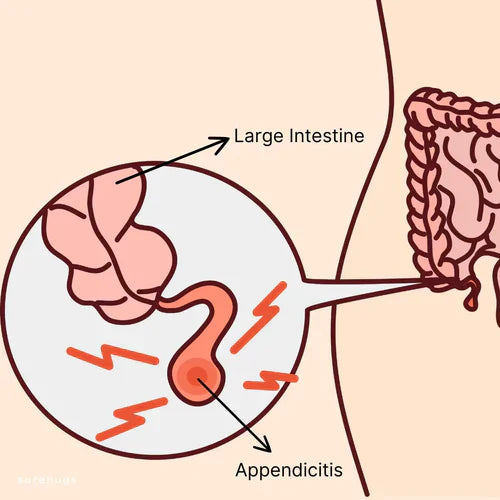Symptoms of Vitamin D Deficiency in Babies | Causes and Treatment

Symptoms of Vitamin D Deficiency in Kids
Vitamin D deficiency is one of the most common and often undiagnosed health issues worldwide. It helps regulate calcium, supports bone health, and reduces the risk of chronic diseases like autoimmune disorders, cancer, and heart disease. Vitamin D deficiency in Kids can lead to rickets, weak bones, and delayed growth. Despite abundant sunlight in India, vitamin D deficiency is widespread across all age groups and genders. About 1 billion people globally are estimated to have low levels of vitamin D, making its adequate intake crucial for health.
Source : Vitamin D Deficiency in Childhood – A Review of Current Guidelines on Diagnosis and Management
14 Signs of Vitamin D Deficiency
- Fatigue and Low Energy: Persistent tiredness and lack of energy can make kids lethargic and less active in their daily activities.
- Bone Pain or Tenderness: Aching bones, especially in the legs and back, may make it difficult for kids to play or move comfortably.
- Muscle Weakness: Children may struggle with basic tasks like climbing stairs, running, or even standing up due to weakened muscles.
- Frequent Illness: A weakened immune system can lead to recurring colds, flu, or infections that take longer to recover from.
- Delayed Growth: Lack of vitamin D may result in slower physical growth, causing kids to be shorter or smaller than their peers.
- Rickets: This severe symptom includes soft or deformed bones, bowed legs, or noticeable skeletal abnormalities.
- Slow Wound Healing: Minor cuts, scrapes, or bruises take longer to heal, indicating poor tissue repair.
- Dental Problems: Weaker teeth, delayed eruption, or increased cavities are common in vitamin D-deficient children.
- Irritability and Mood Swings: Kids may become more irritable, moody, or prone to frequent tantrums due to the deficiency.
- Hair Loss: Severe deficiency can lead to thinning hair or bald patches, affecting a child’s appearance.
- Frequent Fractures: Brittle bones may break easily, even with minor falls or accidents, requiring medical attention.
- Sleep Disturbances: Difficulty falling asleep or frequent waking during the night can affect a child’s overall well-being.
- Poor Appetite: A reduced interest in eating can lead to other nutritional deficiencies and slower growth.
- Difficulty Walking: Bone weakness may cause a waddling gait or mobility issues, requiring medical intervention.
Vitamin D needs for Babies, Children and Teens
Vitamin D is essential for healthy bone development, immune function, and overall health in children and adolescents. Here are the recommended vitamin D dosages based on age groups:
Infants (0-12 Months)
- Breastfed Infants: Should receive a daily supplement of 400 IU (10 mcg) of vitamin D starting from the first few days of life. This is necessary because breast milk typically does not provide adequate levels of vitamin D.
- Formula-Fed Infants: If consuming less than 32 ounces (approximately 1 liter) of vitamin D-fortified formula per day, they should also receive a daily supplement of 400 IU. Most infant formulas are fortified with vitamin D, but infants may not consume enough to meet their needs without supplementation.
Children (1-8 Years)
- Children in this age group should receive 600 IU (15 mcg) of vitamin D daily. This can be obtained through a combination of dietary sources and supplementation if necessary.
Teens (9-18 Years)
- Adolescents should also aim for 600 IU (15 mcg) of vitamin D daily. If they do not obtain this amount through diet (including fortified foods and beverages), supplementation is recommended.
Source : How much vitamin D for children?
Recommended Dose Vitamin D
The recommended daily intake of vitamin D varies by age group to support healthy growth and development :
| Age Group | Recommended Intake (IU) |
| Infant (0 to 12 Months) | 400 IU (10 mcg) |
| Children (1 to 13 Years) | 600 IU (15 mcg) |
| Teens (14 to 18 Years) | 600 IU (15 mcg) |
Sources of Vitamin D
- Sunlight and Food: Sunlight exposure promotes natural vitamin D production, supporting strong bones and teeth. Fatty fish, egg yolks, and fortified foods provide essential nutrients for healthy growth.
- Fortified Options: Fortified milk, cereals, and plant-based alternatives boost vitamin D intake, enhancing immunity and preventing rickets.
- Dairy and Mushrooms: Cheese, butter, and UV-exposed mushrooms supply small amounts of vitamin D, helping maintain proper calcium absorption and overall development.
- Supplements: Vitamin D drops or tablets are beneficial for children with limited sun exposure, ensuring optimal bone strength and immune health.
Are certain children more at risk for developing vitamin D deficiency?
- Children with Darker Skin: Higher levels of melanin reduce the skin's ability to produce vitamin D from sunlight.
- Limited Sun Exposure: Kids who spend little time outdoors or wear sunscreen regularly may not produce enough vitamin D.
- Exclusive Breastfeeding: Breast milk alone may not provide sufficient vitamin D, especially if the mother is deficient.
- Dietary Restrictions: Children with dairy allergies, lactose intolerance, or vegan diets may miss key sources of vitamin D.
- Obese Children: Vitamin D can get stored in fat cells, making it less available for the body to use.
- Certain Medical Conditions: Kids with malabsorption issues, such as celiac disease or Crohn’s, are at higher risk.
Source : Vitamin D Deficiency in Childhood – A Review of Current Guidelines on Diagnosis and Management
How does Vitamin D Deficiency impact Children ? Sign and Symptom
Vitamin D deficiency in children can lead to a variety of health issues, including weakened bones and a compromised immune system. It can cause symptoms like rickets, bone pain, and difficulty in walking. Ensuring adequate vitamin D levels is essential for overall development and well-being.
Vitamin D Deficiency in Babies / Infants
- Rickets Risk: Vitamin D deficiency in infants can lead to rickets, causing weakened bones and growth delays.
- Breastfed Infants: Exclusively breastfed babies may not get enough vitamin D, as breast milk often lacks sufficient levels.
- Symptoms: Signs include irritability, poor feeding, muscle weakness, and delayed motor skills.
- Bone and Immune Health: Vitamin D is crucial for healthy bone development and immune system function.
- Sources: Sunlight, fortified foods, and vitamin D supplements can help meet an infant's needs.
Symptoms of Vitamin D Deficiency in Kids
- Delayed Growth and Development: Slower physical growth or developmental delays in motor skills.
- Bone Pain and Weakness: Discomfort or pain in bones, particularly in the legs, and muscle weakness.
- Rickets: Bone deformities, such as bowed legs or a curved spine, due to weakened bones.
- Frequent Infections: A weakened immune system, leading to increased susceptibility to colds, flu, and other infections.
- Fatigue and Weakness: Persistent tiredness, low energy, and lack of enthusiasm for physical activity.
- Teeth Issues: Delayed eruption of teeth, poor enamel, or increased risk of cavities.
- Mood Changes: Irritability, mood swings, or signs of depression due to the impact of vitamin D on brain function.
- Hair Loss: Thinning or shedding of hair as a result of severe vitamin D deficiency.
What are the Symptoms of Vitamin D Deficiency in Kids Behavior

- Irritability: Kids may become easily upset, frustrated, or moody, showing heightened emotional responses to situations.
- Fatigue and Low Energy: A child may experience extreme tiredness, making them less active, lethargic, or unable to keep up with their usual activities.
- Depression-like Symptoms: Children might exhibit signs of sadness, withdrawal, or a lack of interest in things they usually enjoy, which can affect their overall mood and social interactions.
- Anxiety: Low vitamin D levels may lead to increased nervousness or anxiety, making children feel uneasy, worried, or overly cautious in everyday situations.
- Difficulty Concentrating: Children with vitamin D deficiency may struggle to focus, leading to poor attention spans and difficulty completing tasks, both in school and at home.
- Sleep Disturbances: Deficiency can also cause trouble with sleep patterns, such as difficulty falling asleep or experiencing restless nights, which can impact overall mood and energy levels.
Weird Symptoms of Vitamin D Deficiency in Kids
- Bone Pain or Tenderness: Kids may experience unexplained aches or tenderness in their bones, especially in the legs or lower back, which can sometimes be mistaken for growing pains.
- Hair Loss: Vitamin D deficiency can lead to hair thinning or loss in children, particularly in areas like the scalp, leading to bald patches or overall thinning.
- Frequent Illnesses or Infections: A lack of vitamin D can weaken the immune system, making children more prone to catching colds, infections, or other illnesses more often than usual.
- Soft Skull or "Soft Spots" (in infants): In babies, a vitamin D deficiency may cause the soft spots on the skull (fontanelles) to remain wider and not close properly, which could indicate rickets.
- Teeth Problems: Deficiency may also manifest in delayed tooth eruption or malformed teeth, with the child experiencing cavities or other dental issues earlier than expected.
- Unexplained Muscle Weakness: Muscle weakness or difficulty in performing tasks that require physical strength, such as climbing stairs or lifting objects, may be a subtle sign of vitamin D deficiency.
Vitamin D Levels
Vitamin D is crucial for the health and development of children, particularly for bone health and immune function. The normal vitamin D level in child is typically measured by the concentration of 25-hydroxyvitamin D (25(OH)D) in the blood.
Vitamin D Level Classifications
- Deficiency:
- Levels below 20 ng/mL (50 nmol/L) are considered deficient.
- Insufficiency:
- Levels between 20-29 ng/mL (50-72 nmol/L) are classified as insufficient.
- Sufficiency:
- Levels of 30 ng/mL (75 nmol/L) or higher are generally considered sufficient for optimal health.
Source : Use of Vitamin D in Children and Adults
| Vitamin D Status | Levels (ng/mL) |
| Deficiency | 20 ng/mL (50 nmol/L) |
| Insufficiency | 20-29 ng/mL (50-72 nmol/L) |
| Sufficiency | 30 ng/mL (75 nmol/L) |
Low Vitamin D in Kids
Low Vitamin D in Kids can lead to a variety of health issues, as vitamin D is essential for proper bone growth, immune function, and overall development. When vitamin D levels are insufficient, children may experience:
- Weakened Bones: Low vitamin D can cause rickets, leading to soft, deformed bones and increased fracture risk.
- Delayed Growth: Insufficient vitamin D can slow down physical growth, including height and weight.
- Muscle Weakness: Vitamin D deficiency can lead to muscle pain, weakness, and difficulty with physical activities.
- Impaired Immune Function: Low vitamin D weakens the immune system, making children more prone to infections and illnesses.
Vitamin D Deficiency Treatment
The treatment for vitamin D deficiency varies by age. Infants, older children, and teenagers all require different approaches to treat it.
The following are global recommendations for treating vitamin D deficiency rickets in infants and children :
- Babies under 3 months old:Give 2,000 IU (50 mcg) of vitamin D daily for 3 months.
- Babies 2 to 12 months old:Give 2,000 IU (50 mcg) daily for 3 months, or one dose of 50,000 IU (1,250 mcg).
- Children 1 to 12 years old: Give 3,000–6,000 IU (75–150 mcg) daily for 3 months, or one dose of 150,000 IU (3,750 mcg).
- Children over 12 years old:Give 6,000 IU (150 mcg) daily for 3 months, or one dose of 300,000 IU (7,500 mcg).
Source : Global Consensus Recommendations on Prevention and Management of Nutritional Rickets
Vitamin D Foods

- Fatty Fish: Salmon, mackerel, and sardines are excellent sources of vitamin D and omega-3s, supporting brain and bone health.
- Egg Yolks: A nutritious option packed with vitamin D, essential for growing bones and immune support.
- Fortified Milk and Cereals: Provide added vitamin D to ensure kids meet their daily needs.
- Cheese: A kid-friendly source of vitamin D and calcium for stronger bones and teeth.
- Mushrooms: Some varieties contain vitamin D, especially if exposed to sunlight during growth.
- Orange Juice (Fortified): A tasty way to boost vitamin D intake, often enriched for additional nutritional benefits.
Best Vitamin D for Babies
- Breast Milk or Formula: Breastfed babies may need vitamin D supplements, as breast milk may not provide enough. Formula-fed babies usually get sufficient vitamin D if they consume at least 32 ounces of formula daily.
- Vitamin D Drops: Pediatricians often recommend vitamin D drops (400 IU daily) for newborns and infants, especially for breastfed babies.
- Sunlight: Limited sun exposure (10–15 minutes a few times a week) can help babies synthesize vitamin D naturally. However, care is needed to avoid overexposure.
- Fortified Foods: For older babies starting solids, options like fortified baby cereals or pureed foods with vitamin D can help meet their requirements.
Sun Exposure and Vitamin D
- Natural Vitamin D Source: Sunlight helps the body produce vitamin D, which is essential for healthy bones, teeth, and overall growth in kids.
- Timing Matters: Allowing kids to spend 10–15 minutes in sunlight a few times a week, preferably in the early morning or late afternoon, can boost vitamin D levels.
- Protection Balance: While sunlight is beneficial, prolonged exposure can harm delicate skin. Use sunscreen and protective clothing after a short exposure period.
- Limitations: Cloudy weather, high pollution, or darker skin tones can reduce the body's ability to produce vitamin D from sunlight, necessitating dietary supplements.
How Can i prevent Vitamin D Deficiency
- Sunlight Exposure: Spend 10–15 minutes in direct sunlight a few times a week, especially in the morning or late afternoon, to help your body naturally produce vitamin D.
- Vitamin D-Rich Foods: Include foods like fatty fish (salmon, mackerel), egg yolks, fortified dairy products, orange juice, and cereals in your diet.
- Supplements: If dietary intake and sun exposure are insufficient, consult a doctor about vitamin D supplements appropriate for your age and needs.
- Regular Monitoring: Have your vitamin D levels checked periodically, especially if you belong to a high-risk group, such as people with darker skin, limited sun exposure, or specific medical conditions.
- Balanced Diet: Maintain a balanced diet with a mix of nutrients that work synergistically, like calcium and magnesium, to support healthy vitamin D metabolism.
Activity
Your child can get vitamin D from sunlight. Playing outdoors helps them stay active and get vitamin D naturally.
To prevent sunburn:
- Use sunscreen with SPF (Sun Protection Factor) 15 or higher.
- Avoid spending too much time in the sun between 10 a.m. and 4 p.m. when it's strongest.
Key Points to Remember
- The skin makes most vitamin D when exposed to sunlight. Getting enough vitamin D from food alone is difficult.
- Kids with very dark skin, little sun exposure, or certain health issues are more likely to have low vitamin D levels.
- Vitamin D is important for Teeth , Bone and Muscle Health.
- Kids with low vitamin D should take supplements, spend time outside, and eat enough calcium-rich foods.
Discover Safehugs clothes that care for your little one’s comfort—soft, stylish, and gentle on the skin, offering a safe embrace.
Related:
FAQ'S
1. How much Vitamin D per day for Kids ?
Children need about 400–600 IU of vitamin D per day, depending on their age. For kids over 1 year old, 600 IU is recommended daily.
2. Vitamin D pediatric guidelines ?
Pediatric guidelines recommend 400 IU of vitamin D daily for infants under 1 year, and 600 IU for children 1 year and older. Higher doses may be needed for those with deficiency.
Source : Vitamin D and Breastfeeding
3. How much Vitamin D is too much for Baby ?
For babies, more than 1,000 IU per day for infants under 6 months or 1,500 IU per day for babies 6 months and older can be too much. Excessive vitamin D can lead to toxicity.
4. In which fruit is vitamin D high?
Bananas are a good choice for vitamin D. Figs (Anjeer) are considered a wonderful fruit and are rich in vitamins D, C, A, and B.
5. How to correct vitamin D deficiency in kids?
To correct vitamin D deficiency in kids, ensure they get enough sun exposure and take supplements if needed. Include vitamin D-rich foods like fortified milk and fish in their diet.



























